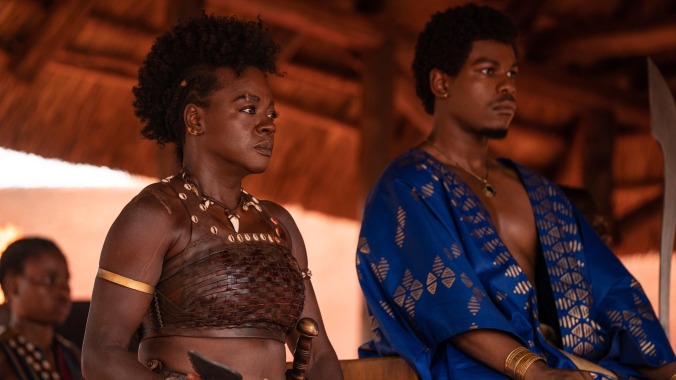The Woman King crowns Viola Davis as a believable badass
An incredible cast holds court in the film, but Gina Prince-Bythewood struggles to balance the action-packed empowerment story with its real-life atrocities

Sometimes it’s the movies that are nearly great, but merely good, that break your heart the most.
Such is the case with The Woman King, Gina Prince-Bythewood’s action-packed historical epic set in the early 1820s in the West African Kingdom of Dahomey (today part of Benin). It is a film designed to inspire audiences and elicit cheers and, by and large, it succeeds. But there are undeniable and frequent moments of woozy disconnect, a square-peg-in-round-hole sensation in which this studio-released picture leaps swiftly from detailing the grim realities of the world’s worst prolonged atrocity—the transatlantic slave trade—to GIF-ready beatdowns. Rarely does a film feature a traumatizing rape scene one minute and killer parkour moves the next.
But it’s a pessimist that dwells on disappointment; optimists focus on what works. It’s likely not a surprise that the performances here are all top-notch. Viola Davis plays General Nanisca, head of the elite female warrior squad known as the Agojie (or “Dahomey Amazons” as they were called by Europeans), in a perfect marriage of actor and character. Sheila Atim and Lashana Lynch are similarly spectacular as her top lieutenants, Amenza and Izogie. The 31-year-old Thuso Mbedu, however, is the real find as the co-lead in the picture, 19-year-old Nawi, who refuses to be married off, so joins the Agojie, functioning as our eyes and ears in this new world.
The Agojie serve King Ghezo, John Boyega, whose restrained performance gets a well-earned laugh out of every raised eyebrow. It’s not Boyega’s movie and he knows it, but when he’s on, he’s great. The Dahomey clash with another tribe, the Oyo, but both are caught in an inherited cycle of darkness initiated by the European slave trade. Ghezo holds his head high in relative righteousness: he stopped Dahomey’s sale of their own people to the whites, and only sells their enemies. Nanisca is the visionary who recognizes this, too, must end, and has an economic plan to go with it.
It’s a serious and uneasy topic, and much of it is handled with respectable honesty. But this is also a studio picture, PG-13 at that, so it needs to sell to all four quadrants. The cross-generational implications of slavery quickly dovetail with a preposterous Twilight Saga-esque love story between Nawi and Malik (Jordan Bolger), a preposterously buff visitor from Brazil whose mother was Dahomey and whose father was Portuguese, who has apparently hitched a ride with his slaver buddy, played by the mustache-twirling Hero Fiennes Tiffin.
Other story points involve some Days Of Our Lives stuff about lost children, and a showdown between Viola Davis and the head of the Oyo army who tortured her years ago. There is a considerable amount of tonal whiplash in between shots of young Nawi using a short sword to snap necks.
Ultimately, the truly terrific performances and effective battle scenes deliver in the thrills department. (The MPAA rating keeps it way, way less bloody than a typical Sunday night on HBO.) There is, unfortunately, a hollow feeling at the end. The Agojie were very much real, but the Hollywood-of-it-all creates a “yay, we just ended slavery” vibe, which, historically, is not really the case. Schindler’s List, another film that tries to get its head around an atrocity too big to ever fully understand, concludes with a glimmer of light, but is more realistic with its “uh, what now?” final moments. The Woman King’s aims are different.
Again, there’s a lot that works in The Woman King. Most striking is the overall look of this film, a production designed to rebuke colonialist notions of Africa, the “dark continent.” The architecture of the King’s palace is richly designed, brimming with color and intricate decorative elements. Rarely does one watch a movie and think “great lighting!” but Prince-Bythewood and cinematographer Polly Morgan earned it here. Also, the costumes (from Star Trek: Discovery alum Gersha Phillips) are extraordinary, weaving fierce looks with fiercer weapons. Why would Lashana Lynch want a rifle when she can file her fingernails into instruments of death? The Woman King’s training scenes are more upbeat than most war pictures (think Stripes instead of Full Metal Jacket) and some of the scenes “at court” (especially with the King’s eunuch majordomo) have a fun Game Of Thrones quality.
Prince-Bythewood, whose Beyond The Lights is one of the most overlooked movies of the last decade, has created a vision of historical Africa that has truly never been seen in a mainstream American movie. For that alone, she deserves a crown.